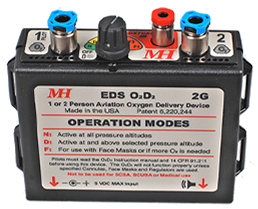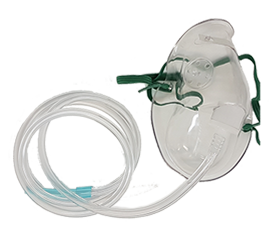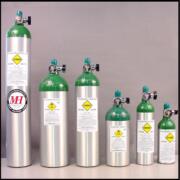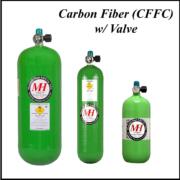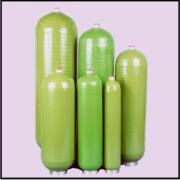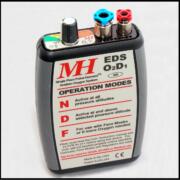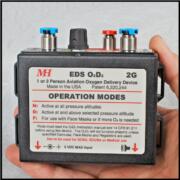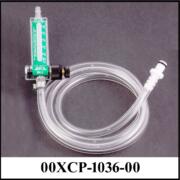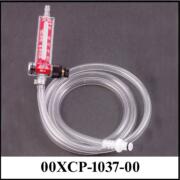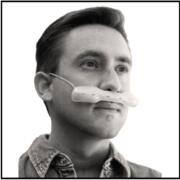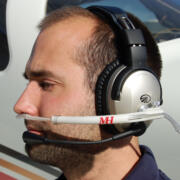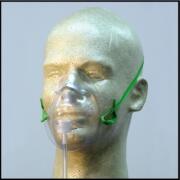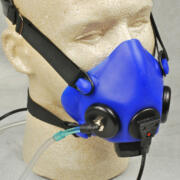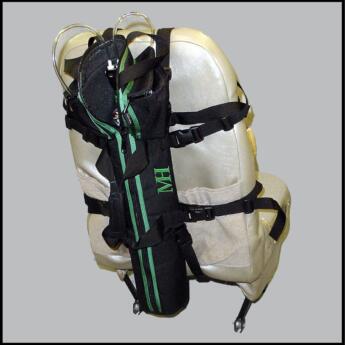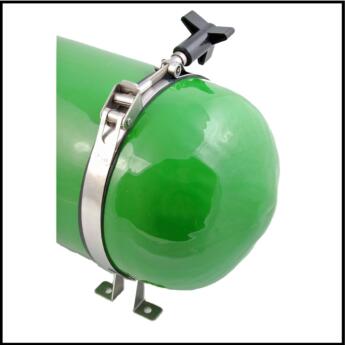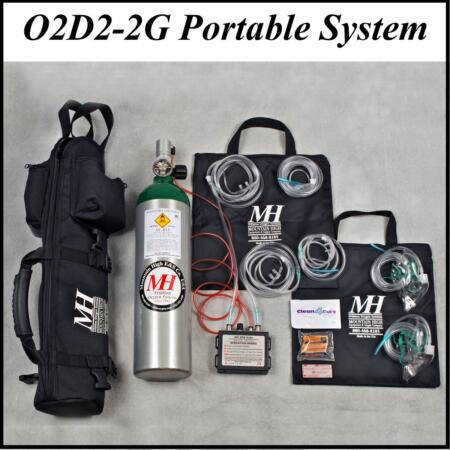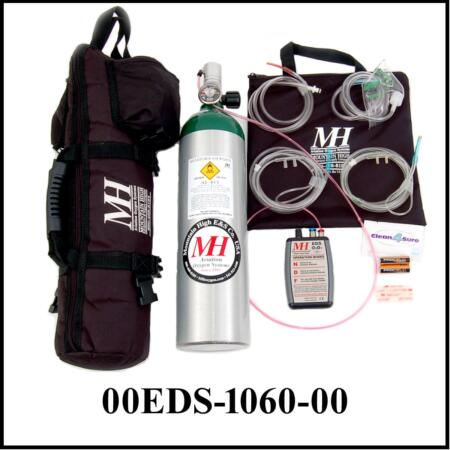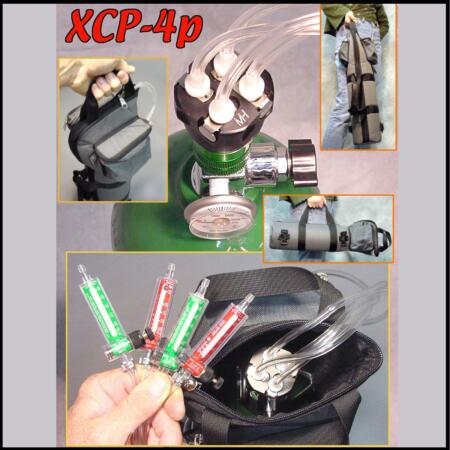Watch Here or Read On
An Oxygen System Consists of 4 Primary Components:
A cylinder, a pressure regulator, a flow control device, and a delivery mechanism (like a cannula or a mask.)
Cylinder
Pressure Regulator
Flow Control
Cannula or Facemask
Step 1:
Choose a Cylinder
Choosing the right cylinder is a cost-benefit calculation of size, weight, capacity, and cost.
Aluminum Cylinders ($)
For most users, an aluminum cylinder is the right fit. Aluminum cylinders are the least expensive cylinders and they come in a variety of sizes from the tiny AL-113, to the popular AL-415, to the long and slender AL-682, our highest capacity aluminum cylinder. Aluminum cylinders have no mandated expiration date (as long as they pass hydro testing which is required every five years).
Carbon Fiber Cylinders ($$)
Carbon fiber cylinders are lighter than aluminum and a little more expensive. In Europe, the CFF-480 can be compressed up all the way up to 3000 psi, meaning significantly more available oxygen. Carbon fiber cylinders have a service life of 15 years (if they pass hydro testing every 5 years), after which they should be retired. One exception: the CFF-480 requires testing every three years.
Kevlar Cylinders ($$$)
Kevlar cylinders are the lightest cylinders money can buy and are an incredible option for those looking to fly light. Our KF Kevlar cylinders require hydro testing every five years, but like carbon fiber cylinders, have a 15-year service life. Our large, KF-115 Kevlar cylinder holds a whopping 3257 liters of oxygen, nearly 5 times the capacity of our largest aluminum cylinder and empty, weighs only twice as much. A KF-115 coupled with an EDS system, provides over 33 hours of oxygen for one person flying at 25,000 feet. At 10,000 feet, that goes up to nearly 200 hours of flying.
Step 2:
Pick the Right Pressure Regulator
Make sure it fits your bottle. Make sure it fits your needs.
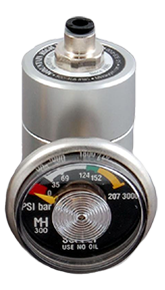
What’s a Pressure Regulator?
A pressure regulator typically sits on top of your cylinder, though there are exceptions. As their name suggests, regulators “regulate” the pressure of the outgoing oxygen from a cylinder, both reducing the pressure and keeping it from fluctuating. Having a controlled and constant pressure is critical in an oxygen system.
CGA-540 vs DIN-477 (US vs European)
When talking about cylinders and regulators, you might run into the terms “CGA-540” and “DIN-477” connector types, which is referring to the size and threading of the valve on the top of the cylinder. CGA-540 is the standard in the US and Canada, while DIN-477 is the German standard used in Europe and elsewhere. For a regulator, valve and cylinder to fit each other, they need to match.
1-port vs 4-port
Regulators come in 1-port and 4-port options. A single-port regulator is suitable for most systems. Four port regulators are designed to connect a cylinder to more than one EDS pulse-demand device (which we’ll talk more about in a moment) and/or constant-flow station. A 4-port regulator automatically seals unused ports, which is why you don’t see a 2-port or 3-port regulator option—it is 4 regulators in one. Also, with a 4-port regulator, you can connect both an EDS pulse-demand device and a constant-flow station to the same cylinder.
Thinking of Using an EDS? Use a Mountain High Regulator
When using a Mountain High pulse-demand oxygen delivery system, your regulator must deliver oxygen between 15-25 psig, for this reason we recommend using Mountain High regulators which are specifically designed for use with our EDS pulse-demand systems. The good news: All our regulators are compatible. If you buy a constant-flow system now and decide to upgrade to and EDS system later, you can use the same regulator.
Choosing the Right Fitting
You’ll need to connect your regulator to the flow control device, so your fittings and connectors will need to match up. If you have any questions, give us a call. We also have ready-to-go-systems so you don’t need to worry about your devices not connecting.
In-line Regulators
For built-in systems to connect to an EDS system, an inline, reducing regulator is required. This connects to the onboard oxygen supply and reduces the pressure so that it meets the pressure requirements of the EDS.
Step 3:
Choose a Flow Control Device
Pulse-demand™ or constant flow?
EDS Pulse-demand Device (O2D1, O2D2)
The simplest and most efficient way to control oxygen flow is with an EDS pulse-demand device. The EDS delivers a “puff” of oxygen only when a user inhales, allowing for dramatics savings in oxygen. Additionally, the EDS monitors pressure altitude and breathing patterns and measures the needed oxygen automatically, so no manual adjustment is needed during flight. The EDS is available in both a single-place model (O2D1) and dual-place model (O2D2).
Flowmeter (MH3, MH4)
Another way to control oxygen flow is with a flowmeter. Flowmeters come in two models: the green MH3, is the more efficient of the two, and is suitable up to 18,000 feet. The red MH4 flowmeter conserves less oxygen but can be used up to 30,000 feet. With either flowmeter, users turn a dial on the side of the flowmeter to adjust the flow of oxygen. A ball floats inside to indicate the appropriate flow for a given altitude. For example, a person flying at 15,000 feet would adjust the dial so that the ball floats at the 15,000 feet mark. Simple and inexpensive, flowmeters provide a way to have oxygen onboard without a large up-front investment. A constant-flow system like this is great for those who only occasionally fly at higher altitudes or who want to quickly fly over weather or mountains.
Step 4:
Choose Masks and/or Cannulas
Cannulas
Cannulas are lightweight, efficient, inconspicuous, and allow for easy conversation as your mouth is not covered.
Simple cannulas get the job done in most cases. For constant-flow systems, you might consider an Oxymizer cannula.
If you don’t want that tubing hanging around and you’d like to mount a cannula to your headset, take a look at our very popular EZ Breathe Cannulas.
Facemasks
A facemask covers both your nose and mouth, and is required by the FAA once you reach 18,000 feet. Also, if you do a lot of talking or if you generally breathe through your mouth, a cannula may be less effective and a mask may be preferable.
A mask can be simple and inexpensive, or more robust like our ALPS facemask which can come with a built-in microphone.
*Step 5:
Mount your Cylinder
Here are some quick solutions to mount your cylinder in your aircraft:
Fullpack
We created a simple solution which works great for most applications. The Fullpack is a sturdy carry case made of a padded GorTex fabric with “D” rings strategically placed so the harness can be securely mounted to a seat-back or any other suitable surface where it can be accessed while in flight. A wide variety of sizes available.
CMK Cylinder ‘Hold-Down’ Mounting Kits
The CMK bracket cylinder mounting kit is a rigid, low profile, high-strength method of securing Aluminum or Composite-Fiber cylinders to a flat surface. With the CMK brackets bolted in place, the cylinder is held into place by a set of stainless steel taut-bands. Two (2) styles of taut-bands are available: standard-issue, ‘closed-loop’ Type-01, and Type-02 quick-release or ‘open-loop’ type where the cylinder is easily placed and removed by loosening the gripknobs, then uncoupling the quick-release latch on the bands.
The Simple Option: A Complete Oxygen System
Get everything you need in a complete system
If you want things even simpler, we’ve taken the confusion out of oxygen systems by creating complete systems with everything you need to fly. The kits below include everything you’ll need in a system and will still allow you to choose your cylinder size and some other options (depending on the kit).
EDS O2D2 System
(Two-place, Pulse-demand™)
(Pick your cylinder. Regulator, EDS, masks, cannulas, and Fullpack carry case included.)
EDS O2D1 System
(Single-place, Pulse-demand™)
(Pick your cylinder. Regulator, EDS, masks, cannulas, and Fullpack carry case included.)
XCP (Flowmeter) System
(Variable-place, Constant Flow)
(Pick your cylinder and flowmeter. Regulator, EDS, masks, cannulas, and Fullpack carry case included.)
Cylinder Duration Chart
Compare oxygen duration times between systems with our Cylinder Duration Chart:
Still Have Questions? Contact Us!
Feel free to give us a call or send us a message via our contact form. We’re pros at this and we’d love to help you figure out what you need and even solve problems.


